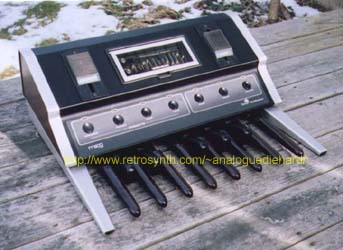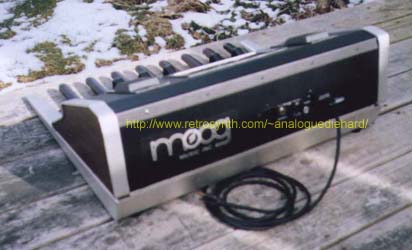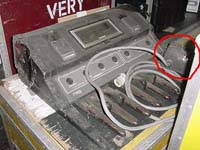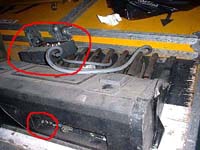Moog Taurus I Bass Pedal Synthesizer
Update 06-14-2014
The Moog Taurus I is a self-contained synthesizer famed for its
earthquake-inducing bass timbres. It does one thing, and does it
well... BASS. It was
originally designed as one of a trio of synths for the Moog
Constellation system, which consisted of the Lyra (a monosynth that
never made production), the Apollo (the Polymoog prototype), and the
bass pedal synth which became the Taurus. The Lyra and Apollo
currently exist in the Audities collection in Calgary Alberta Canada
but the prototype bass pedal synth is long gone. Like the
Minimoog, the Taurus stands as the standard against which all other
bass pedals are measured.
I had wanted a clean set of Taurus pedals for a long time. Most
of the ones that show up on auction sites or in stores had been well
gigged, were ratty, or needed repair. The market value for Taurus
pedals was $2,000 and climbing - higher than a vintage Minimoog.
Pretty absurd prices for a synth that does little other than bass
sounds. I was checking out one of my regular jaunts, a vintage
guitar store that sells vintage Fenders, Gibsons, and PRS guitars. On
occasion they have a synth or combo organ. They had an excellent
condition Moog Liberation a few years prior with a fairly high price
tag, it took them over a year to sell it. This store had also
sold vintage accordians, and I spotted an oversize accordian case in an
inconspicuous place.
My curiousity was aroused. "That's an awful big accordian".
Popped the case open and inside was a pristine set of Taurus
pedals. They weren't even on
display! Spotless case, no broken pedal keys, missing the
window/bezzle over the controls. On the handle was a price
tag. On disbelief I took the case to the counter to confirm the
price. The price they were asking was less than half the market
value! They had belonged to an employee of the store. After
doing a quick run-over of the pedals, I immediately bought them. This
was a lucky find, as this was a reputable store that sells vintage
guitars and
has net connections so they can check auction sites and other stores
for current values. You would think that after selling a 1959
sunburst Les Paul Standard at market value (yes they have had them in
that store) that they would know the value of Moog Taurus pedals...!
The case was a factory polymer molded case with stiff foam supports
inside. A peek at the old Moog Music price lists shows that the
case was offered only for a couple of years, last in 1976. The
inspection tag inside the pedals dates it to 1976, a year after they
were introduced. The pedals were so clean that I don't think they
have ever seen a stage. I called around and Mike Bucki had NOS bezzles and
could make the window assembly. I got them in a couple of weeks
and the window looks like the original, even the VARIABLES label looked
authentic. I only had to add magnets so that the window would
stay closed when I moved them. Many Taurus pedals are missing the
window/bezzle
because they were friction fit to the case and they often worked
loose. I had to secure them from the inside using RTV, worked
like a charm.
According to Bob Moog, the Taurus I pedals were designed not by Bob but
by Dave Luce, who also designed the Polymoog. Dave copied the
Taurus filter from the 904A low pass filter module of the Moog modular
systems. Dave Luce's name appears on the three US Patents for the
Taurus pedals (further reading on Don Tillman's
site).
The 13 note Taurus has three preset sounds, plus a fourth "variable"
which is a
user configured sound using the controls in the middle of the
panel. Encompassing the control panel are a pair of foot
controlled slidepots, one for volume, the other for filter
cutoff. These work for all the sounds and are useful for varying
the presets. Above the pedalboard are footswitches - four for the
presets, then glide, decay (release actually), and octave. The
presets are labeled "Bass", "Tuba", and "Taurus".
"Bass" is a
dual VCO synth bass sound with a rapid decay transient that begs to be
sequenced or be played by hand. "Tuba" is a
single VCO sound that
has better use when processed, IE stereo chorus. That single VCO
is one solid bass sound though. "Taurus" is
the famed sound
favored by prog rock groups like Genesis, Yes, Asia, UK, and Rush as
well as Motley Crue and The Police (Andy Summers had a set, Sting had a pair in front of him).
The control panel defines the "variable" sound - you are given control
over footage from lo-mid-hi (shared with both VCOs), VCO A/B mix, VCO B
frequency (little over an octave), VCA Attack/Decay (actually Release),
VCF Attack/Decay, VCF Cutoff, Emphasis, and Contour Amount. These
controls do not affect the presets, they are set by fixed
resistors. Three other controls - Glide, Beat, and Tune - work on
all the presets. Beat is like a master detune control for the
VCOs. The VCOs are rising ramp waveforms only - they are not falling
ramp as illustrated in the Taurus user/service manual. There is a
SUSTAIN LEVEL control grouped with the VCA Attack/Decay but it is not
the traditional SUSTAIN parameter associated with the industry standard
ADSR EGs. It is actually a volume control for the "variables"
preset, similar to the contour amount for filters. The VCA EG is
A/R with full sustain, the VCF EG is A/D with zero sustain.
Bass is the Taurus pedals' forte. Below are samples of some sounds
under the
"variable" palette. These are best heard/felt with subwoofers or
headphones, you won't hear that deep bass with generic PC
speakers. None of these sounds have any processing or EQ.
Shoes make a difference playing the Taurus pedals. Hard flat
soles work the best, long accepted by organ players in churches and
theaters. Sneakers don't work as well, particularly when using
the footswitches. There is too much "sponge" in soft sole shoes
and you don't get the firm playing tactile response you do with hard
soled shoes.
I own other Moog keyboards - Memorymoog, Minimoog, Source, Polymoog,
Liberation, Voyager. The Source was my primary bass keyboard
since 1985. They could hold their own against the Taurus, but the
Taurus has that indefinable oomphTM
that separates it from the rest. It is true that the Source can
emulate the Taurus pedals as I have copied the sound, but something was
still missing. The sound of the famous "Taurus" preset opens with
a throaty growl, then settles to a pleasant distinctive purr as the
filter cutoff decays. The growl and filter decay was easy to
emulate on the Source, but that purr wasn't quite the same.
The "Tuba" preset demonstrates how massive and solid just one Taurus
VCO can sound. None of my other Moogs sound this big. I use
Rane line mixers with no EQ so there is no question of EQ
differences. I could get the growl and filter decay of the
"Taurus" preset on the Source but it didn't have the mass of the Taurus
VCO. What was missing?
There is a myth that the Taurus is fatter because of the linear v/hz
VCOs. An exponential VCO, used in Minimoogs and just about every
other synth, contains a linear voltage to exponential current converter
followed by a ramp generator based around a charged cap with reset
pulse. A study of the Taurus VCO reveals the same circuit
minus the exponential converter - giving it a linear v/hz response yet
with no difference in the audio sonority in the ramp generator.
My first gigging synth was a PAiA 4700 modular with linear v/hz VCOs
and these were far from the obesity of a Taurus VCO.
So why do Taurus pedals sound so big? One answer is the coupling
between the VCF and the VCA. The service manual states that the
AC coupling between the VCF and VCA was designed so that the RC product
would increase the bass at a corner frequency of 20hz. There is a
bass boost built into the Taurus pedals! According to Bob Moog,
Dave Luce simply lifted the filter design right out of the modular -
the 904A low pass filter module is one mighty big sounding filter so
there is no question about that.
The other element of the bigness of Taurus I pedals is distortion in
the waveshape. This is due to two factors 1) the filter is driven
pretty hard which introduces harmonics 2) the filter feedback recovery
amp and the VCA are CA3080 OTAs which are NOT high fidelity devices, they
actually introduce subtle distortion. This changes the timbre to
the point
that the fundamental is emphasized. This also introduces a
compression effect via overdriving the filter. This is also why
Taurus
I pedals do not suffer from phase cancellation of dual detuned VCOs as
the timbre animation cycles around.
So that "bass boost" is the "purr" that is missing from the
Source. Therefore the Taurus bass sound remains unique.
Many analog synths need a 10-20 minute "warm-up" period for the VCOs to
come in tune - the reason is that the expo converter has a temperature
factor that affects its conversion. When power is applied the
components heat up over time, settling at an operating temperature
higher than ambient temperature. During this "heating period" the
expo converter will be inaccurate, which means the VCOs will not be in
tune. Once operating temperature is reached, the VCOs are in
tune. Because the Taurus is lacking the expo converter in its
linear v/hz VCOs, there is no warmup time needed to wait for the VCOs
to tune - they are ready to play when you turn them on.
Why do the Taurus use linear v/hz VCOs? One, it is a one octave
pedalboard therefore octave switching is trivial. Two, no
modulation of any kind (pitch bend, mod wheel) is needed for a bass
synth.
The "Taurus"
preset doesn't suffer from phase cancellation of dual detuned VCOs,
which led to the myth that the
Taurus pedals contain some kind of compression - not true, say the
schematics. What the schematics DO reveal is that the mix level
of the
VCOs are not equal on the
"taurus" preset - if you turn down the level of one of the VCOs, the
phase cancellation is minimized while you can still hear the timbre
animation. This is a trick I have been using on the Source since
I
bought it back in 1985.
You haven't heard justice done to Taurus pedals until you play them
through a proper PA system. I have a two way PA system consisting
of a
pair of JBL SF25s (2x15 plus titanium tweeter) and two pairs of EV
S-181
subs
with 18" speakers. This is a big sounding system, hall-caliber
quality. Those subs got a workout with the Taurus
pedals, they have some serious BOOM that you won't hear on small studio
speakers. I never felt such subsonics in my life. Now I
know what a Genesis or Rush concert experience would have felt like (I
never caught either in concert).
The Taurus I pedals were in production from 1974 to 1981. From
1982 to 1985 a second version called the Taurus II was released which
is an 18 note pedalboard with the synth "brain" module suspended at
playing height via a pole. The electronics of the Taurus II is
identical to the compact Rogue synthesizer with the exception of the
keyboard CV circuit. While this model has more features, it is a
pale imitation to its predecessor. It does not have the big bass
sound of the original Taurus I. There was also rumor of a Taurus
III. No such device by that name was ever made, it is likely
confused with the Taurus Controller which is the Taurus II pedalboard
minus the synth "brain" module - it has trigger and CV outputs, but no
synthesizer circuits inside.
The achilles heel of Taurus I pedals are the pedal key contacts.
They are exposed to the floor and the elements which leaves them
vulnerable to collecting dust and debris. The contacts are also
silver plated which can tarnish and render a key to malfunction.
If a range of keys from high C below stops working, it is dirty
contacts. The best way to clean them is to remove the circuit
board containing the contacts and apply Tarn-X tarnish remover with a
pipe cleaner. Any tarnish remover will work but Tarn-X is a
strong cleaner. WARNING - use Tarn-X in
a ventilated area, the fumes are mighty noxious!
If you tire of
cleaning dirty key contacts once a year, Kevin
Lightner makes a replacement key contact PC board that uses high
reliability leaf switches in place of the silver plated spring
contacts. This is a complete circuit board which is a direct drop
in replacement. I bought a set and have been very happy with them.
Another foible of Taurus I pedals is failing frequency divider
trimpots. These do not age well and will cause the pedals to go
out of tune when you move them. The service manual has a
procedure for replacing them with standard trimpots and
resistors. The lubricant in the slidepots can dry out and make
them sticky. Mike Bucki tells me that petroleum jelly can be used
to re-lube them but I would recommend Dow Corning 7 lubricant as
anything containing petroleum distillates or byproducts will damage the
bushings making them swell up. I also question whether a
petroleum-based lubricant would have a corrosive effect
on the resistive element of the slidepot.
The pedal keycaps can break. The best way to prevent that is to
use the Taurus on a rug or a small remnant. Lowrey and Moog were
both owned by Norlin back in the 70s so Lowrey supplied the pedalsets
used in the Taurus. If you need keycaps they can be scavenged
from Lowrey home organs, however the keycaps on the current Lowrey
organs are not the same.
There is a great big cap plug on the rear panel of the Taurus I
pedals. This was supposed to be a connector to an external
accessory box that allowed external control of the "variables"
controls. There were connectors on the Taurus circuit board ready
for this accessory, which according to the user manual was available
from the Custom Engineering department of the original Moog
Music. Mike Bucki worked in the Custom Engineering department and
he has never seen this accessory box, ever. David Kean of
Audities tells me that Dave Luce had planned this interface to work
with the Polymoog (carrying some design proposals from the original
Moog Constellation), but that feature never came to fruition - too many
engineering changes to the Polymoog prevented any development on it.
Although Mike Bucki has never seen the accessory box, I spotted a web site that had
pics
of a set of well-worn Taurus pedals belonging to Genesis. There
is a box laying on the pedals (highlighted in pics below) with a
circular multipin connector at its cable end. The box appears to
contain slidepots of similar model and layout of the Taurus control
panel, and the cap plug on the rear panel is replaced with what appears
to be a mating connector. This may a very rare example (maybe the
only one) of the optional accessory box for the Taurus Pedal.
Adding MIDI I/O to a Taurus I is not trivial as there are no interface
I/O jacks. Kenton used to offer a decent MIDI interface that is
long out of production. You need a CV converter that generates a
v/hz CV signal, not the more common v/oct. You'll have to drill
some holes for jacks. There are a few companies that offer
suitable converters. I'm not happy with the current solutions -
the aforementioned Kenton Taurus MIDI kit was the best solution.
It avoids calibration issues with CV trimming, includes a MIDI out that
the others do not, and activates the footswitches in response to MIDI
controls. Since I want to add MIDI to my Taurus pedals, I am
planning a homebrew MIDI interface patterned after the Kenton solution
using a PIC controller. Since the Taurus circuit board was ready
to accept an external accessory box, I may attempt to access those
points using MIDI CCs converted to CV control.
Can the Taurus I pedals be cloned? The circuit uses standard
parts, but the keyboard circuit used a custom integrated resistor array
that is no longer available and the CA3080 OTA is becoming a member of
the endangered species list. The Taurus I case itself would be
expensive to reproduce and a pedal set would not be cheap. A
faithful reproduction of the Taurus I pedals would have to be an
accurate clone of the voice circuits as the sound is critical.
One could clone the Taurus I synthesizer circuit in a
tabletop or module form and use an aftermarket MIDI pedalboard to get
the same function (less the footswitches), and it would cost less than
a faithful reproduction.
Fortunately, Moog
Music has reissued the Taurus pedals in the form of Taurus 3, which
is a faithful reproduction of the Taurus voice with
added bells like MIDI and programmability. A limited run of 1000
units proved so popular that they built past that - serial numbers are
approaching 1500. Moog has just announced the Minitaur which is a
tabletop synth with the Taurus voice but with some features stripped to
make it more affordable.
Why is there a big appeal for the Taurus I pedals? Why do people
pay over $3,000 for a used set, even ones that are broken? Why do
vintage synth dealers have a waiting list of customers wanting Taurus I
pedals? One attribute is the sound - they possess the beefiest
most solid bass sounds I've ever heard. One user claims to have
witnessed chairs moving on the hall floor when he was testing his
Taurus pedals at a soundcheck. Another memorable auction
description describes the Taurus pedals as "so fat you'll have to put
your studio on a diet". A second attribute is the package - the
layout of the Taurus controls is optimized for operation by foot.
It is easy to change the sound without using your hands, which is
important for bass and guitar players. A third attribute is it
just looks so cool - I'm particular to traditional hardwood like the
cases of Minimoogs, but the Taurus pedals just looks right with that
aluminum trim, dark grey casing, and protruding legs by the pedal keys.

Home






